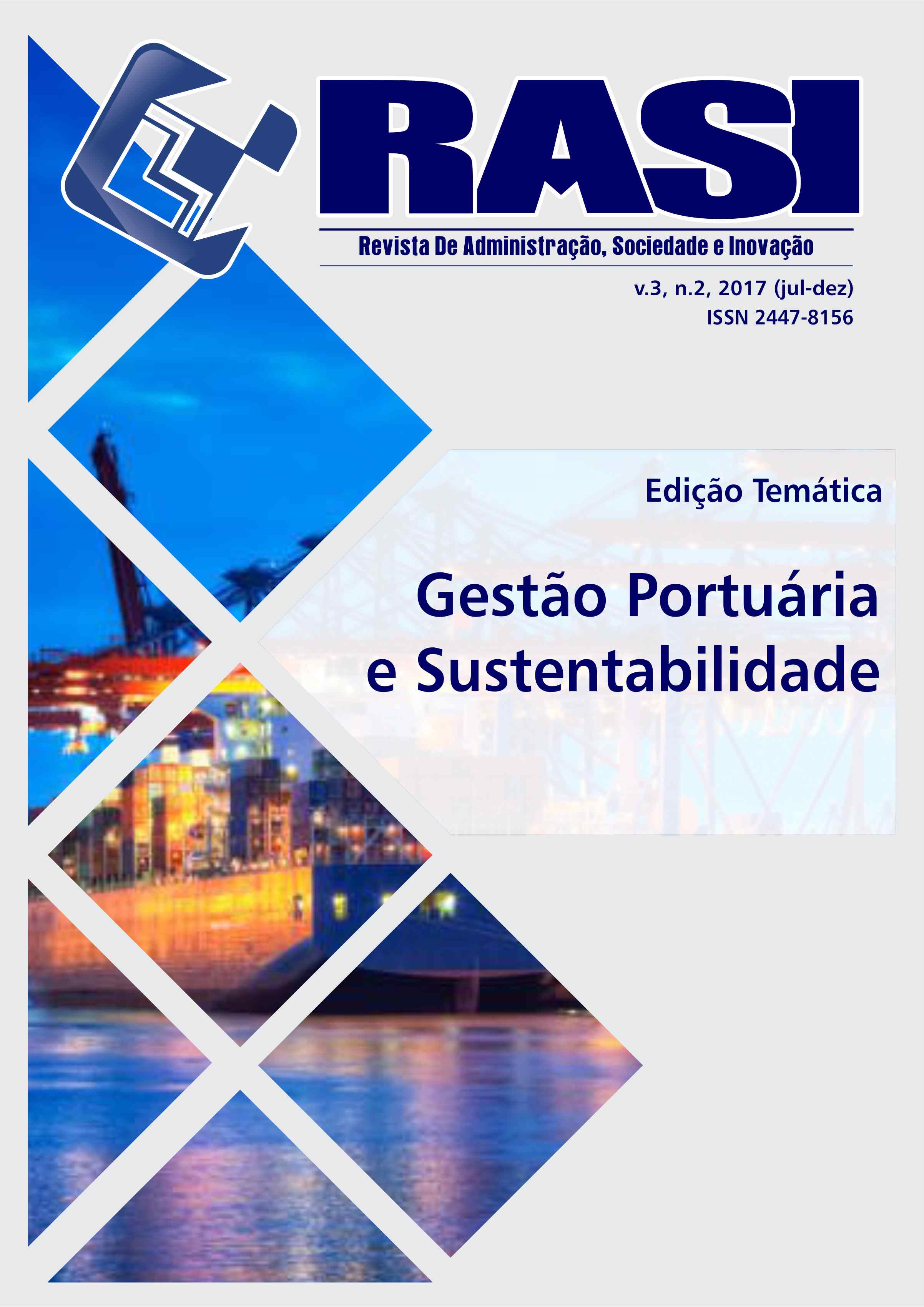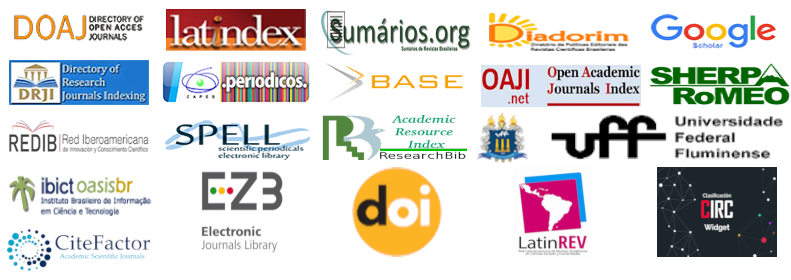Avaliação de aspectos e atributos de sustentabilidade para priorização de projetos de dragagem em portos
DOI:
https://doi.org/10.20401/rasi.3.2.173Palavras-chave:
dragagem, portos marítimos, priorização de projetos, stakeholders, atributosResumo
Dada a relevância dos portos para a economia de um país e para a competitividade das empresas, neste artigo apresentam-se aspectos e atributos, identificados por meio da literatura nacional e internacional, utilizados para priorizar a dragagem em portos marítimos. Com base em pesquisa realizada com os stakeholders, foi definida a importância de cada aspecto e atributo no processo de tomada de decisão considerando-se três grupos de respondentes denominados: academia, empresa e governo. Assim, por meio da aplicação da Analytic Hierarchy Process – AHP, identificou-se que há consenso entre os grupos pesquisados quanto a maior importância dos atributos relacionados ao aspecto econômico enquanto que os sociais são considerados menos importantes. Com base nos resultados, conclui-se que é necessário combinar diferentes atributos para priorização dos projetos de dragagem nos portos brasileiros e que há diferentes visões entre os stakeholders. Como implicação prática, este artigo fornece informações para suportar as políticas públicas do setor de transporte e tomada de decisão pelos gestores de organizações públicas e privadas. Além disso, aponta uma direção para as pesquisas de acadêmicos com relação ao tema. Para novos estudos propõe-se considerar um maior número de stakeholders e utilizar os aspectos e atributos considerados relevantes para priorizar portos a serem dragados em um caso real.
Downloads
Referências
Alfredini, P.; & Arasaki, E. (2014): Obras e Gestão de Portos e Costas: A Técnica Aliada ao Enfoque Logístico e Ambiental– Brazil
Alvarez-Guerra, M., Viguri J. R., Casado-Martínez M. C., & Delvalls T. A. (2007):
Sediment Quality Assessment and Dredged Material Management in Spain: Part II, Analysis of Action Levels for Dredged Material Management and Application to the Bay of Cádiz. –Spain
Angonesi L. G., Bemvenuti C. E., & Gandra M. S. (2006): Effects of Dredged Sediment Disposal on the Coastal Marine Macrobenthic Assemblage in Southern Brazil. – Brazil
ANTAQ (Org.) (2015): Statistical Yearbook Waterway- Brazil
ANTAQ (Org.) (2011): Statistical Yearbook Waterway- Brazil
ANTAQ (Org.) (2009): Grants for Technical Areas Destined Identification of Organized Ports Installation or Private Use Terminals authorization in Support of the General Concession Plan: Base Review and Adjustments Georeferenced- Brazil
Bebianno, M. J., Pereira, C. G., Rey, F., Cravo, A., Duarte, D., D'errico, G., & Regoli,
F. (2015): Integrated approach to assess ecosystem health in harbor areas- Science of the Total Environment – Portugal
Castro, S. M., & Almeida, J. R. (2012): Dredging and environmental conflicts in classicand modern harbors: a revision –Magazine Society and Nature – Brazil
Collier, Z. A., Bates, Z. A., Wood, M. D., & Linkov, I. (2014): Stakeholder engagement in dredged material management decisions - United States
Fadda, E. A. (2012): Legal Instruments Applied to dredging in Brazil–Magazine Customs Law - Brazil
Fettweis, M., Lancker, V. V., Baeye, M., Martens, C., Francken, F., Michielsen, T., Lauwaert, B., & Eynde, D. V. (2011): Monitoring the effects of disposal of fine sediments from maintenance dredging on suspended particulate matter concentration in the Belgian nearshore area (southern North Sea) - Marine Pollution Bulletin - Belgium
Fórum De Direito Marítimo, Portuário E Logística Do Estado Do Ceará (2012) – A Diagnóstico dos Portos Marítimos. III Fórum de Direito Marítimo, Portuário e Logística do Estado do Ceará. Agosto de 2012 - Ceará
Gomes, L. F. A. M. (2004): Decision making in complex scenes : introduction to discrete methods of multi-criteria decision support - Brazil
Gomes, L. F. A. M.; & LIMA, M. M. P. P. (1992). From Modelling Individual Preferences to Multicriteria Ranking of Discrete Alternatives: A Look at Prospect Theory and the Additive Difference Model
Guimarães, V. A.; Accetta, D.; Leal Junior, I. C; Silva, S. D.; Moura, F. G. A.; Siqueira, G. A.; & Montenegro, T. R. (2016): Selection of criteria for dredging prioritizing in seaports. PIANC-COPEDEC IX, 2016, Rio de Janeiro, Brasil
Kapsimalis, V., Panagiotopoulos, I., Kanellopoulos, T., Hatzianestis, I., Antoniou P., & Anagnostou, C. (2010): A multi-criteria approach for the dumping of dredged material in the Thermaikos Gulf, Northern Greece- Journal of Environmental Management- Greece
Kiker, G. A., Bridges, T. S., Varghese, A., Seager, T. P., & Linkov, I. (2005): Application of Multicriteria Decision Analysis in Environmental Decision Making - Integrated Environmental Assessment and Management – United States
Leal Jr, I. C. (2010). Método de Escolha Modal para transporte de produtos perigosos com base em medidas de ecoeficiência. Tese de doutorado. Rio de Janeiro: UFRJ/COPPE, 2010
Lobedan, F. R., LaBasco, T., & Ogunfunmi, K. (2012):Wharf embankment and strengthening program at the Port of Oakland-Soil Dynamics and Earthquake Engineering – United States
Lukens, J. L. (2000):National Coastal Program Dredging Policies: An Analysis of State, Territory, & Commonwealth Policies Related to Dredging & Dredged Material Management - OCRM/CPD Coastal Management Program Policy Series, Technical Document 00-02 – United States
Manap, N., Voulvoulis, N. (2014): Risk-based decision-making framework for the selection of sediment dredging option. 2014. Science of the Total Environment – United Kingdom
Marine Sacs Project (Org.). (2006): Environmental impacts of dredging on seagrasses: A review.– United States
Ministry Of Transport (Org.) (2007): National Plan of Logistics and Transport : Executive Summary - Brazil
Ministry Of Transport (Org.) (2009): Executive Report PNLT - Brazil
Ports Australia (Org.)(2014): Dredging and Australian Ports: Subtropical and Tropical Ports- Australia
Saaty, T. L. (1980): The Analytic Hierarchy Process: Planning, Priority Setting, Resource Allocation- United States
Scheffler, A., Roth, T., & Ahlf W. (2014): Sustainable decision making under uncertainty: a case study in dredged material management - Environmental Sciences Europe.
SEP - SECRETARIAT OF PORTS (Org) (2014): Brazilian Port Sector and the National Dredging Program II – Brazil
SEP - SECRETARIAT OF PORTS (Org.)(2012): National Plan for Port Logistics : Master Plans - Brazil
Sheehana, C., Harrington, J. (2012): An environmental and economic analysis for geotube coastal structures retaining dredge material- Resources, Conservation and Recycling - Ireland
Smith, T. W. P.; Jalkanen, J. P.; Anderson, B. A.; Corbett,, J. J.; Faber, J.; Hanayamas, S.; O’keeffe, E., Parker, S., Johansson, L., Aldous, L., Raucci, C., Traut, M.; Ettinger, S.; Nelissen, D.; Lee, D. S.; NG, S.; Agrawal, A.; Winebrake, J. J.; Hoen, M., Chesworth, S. E.; & Pandey, A. (2015) Third IMO GHG Study 2014. International Maritime Organization (IMO), Londres, Inglaterra.
Stopford, M. (2008): Maritime Economics. Taylos and Francis. 3rd edition.
UNCTAD (2016) Review of Maritime Transport 2015. United Nations publication. Sales no. E.16.II.D.7. New York and Geneva
Vikolainen, V., Bressers H., & Lulofs K. (2014): A Shift Toward Building with Nature in the Dredging and Port Development Industries: Managerial Implications for Projects in or Near Natura 2000 Areas - Environmental management - Netherlands
Downloads
Publicado
Edição
Seção
Licença
A RASI, de acordo com a Lei nº 9.610, de 19.02.98 que altera, atualiza e consolida a legislação sobre direitos autorais e dá outras providências, adota as seguintes condições da Cessão de Direitos Autorais:
- A Revista de Administração Sociedade e Inovação (RASI) mantém, com a cessão dos direitos autorais, a posse dos direitos sobre os conteúdos por ela publicados;
- O autor retém seus direitos morais do conteúdo, incluindo o direito de ser identificado como autor sempre que o conteúdo for publicado;
- Apesar da atribuição dos direitos autorais o autor retém o direito de reutilizar o material em coleções futuras de seu próprio trabalho sem ônus. Os reconhecimentos da publicação anterior na RASI são as únicas exigências em tais casos;
- O autor pode fazer fotocópias do conteúdo, ou distribuí-lo por meio de correio eletrônico ou fax, desde que destinadas às suas próprias aulas e com finalidade de atender objetivos de pesquisa, sob a condição de que: (a) tais cópias não sejam revendidas e (b) referência a fonte original da publicação e o nome da RASI estejam indicados claramente em todas as cópias feitas do material.











